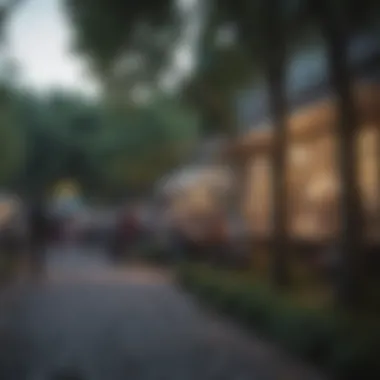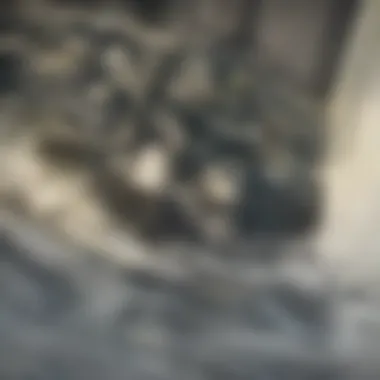Exploring The Avenue GWU: Architecture and Community


Intro
The Avenue at George Washington University is more than just a physical space; it represents a blend of architecture and community. Understanding this dynamic is essential for grasping how this area contributes to the campus experience. The Avenue is not only significant for its striking designs but also for how it integrates into student life and interacts with the wider community. This article explores the intricate details of its architecture, its role in student well-being, and future aspirations for the space.
Exquisite Architectural Designs
Unique Home Features
The architectural design of The Avenue showcases several notable features. Each building is crafted with an emphasis on functionality while maintaining aesthetic appeal. For instance, the use of large windows allows for natural light, enhancing the feel of openness within the spaces. The materials reflect modern sensibilities but also resonate with historical context, ensuring cohesion with nearby structures. In addition, communal spaces are carefully curated to foster interaction. These areas help create a vibrant atmosphere, facilitating not only student gatherings but also community events.
Historical Significance
The historical context of The Avenue adds layers to its architectural narrative. Originally envisioned as part of a larger strategy to develop the campus, it represents a shift in how educational institutions can integrate community and environment. The design respects the historical significance of the surrounding area, echoing architectural styles prominent in Washington D.C. Furthermore, this hybrid construction typology not only supports current needs but anticipates future community trends, making it a relevant case study for modern educational architecture.
"The Avenue embodies the essence of an educational community, where architecture and purpose intersect to create a nurturing environment."
Integrating The Avenue Into Campus Life
The Avenue is intentionally designed to bridge gaps between academic and social experiences. By providing a variety of amenities, it becomes a central hub for student interaction. Cafes, study lounges, and event spaces dot the landscape, encouraging a blend of studies and leisure. This integration promotes a community-focused culture that enhances student engagement. Beyond functionality, the setting is also designed to promote inclusivity and accessibility, ensuring that every student feels welcome.
Nearby Amenities and Community Impact
The surrounding area of The Avenue is rich with amenities that complement its offerings. Within walking distance, students find resources like gyms, libraries, and recreational areas. These conveniently located services enhance daily life, making necessities easily accessible.
Future Vision for The Avenue
Looking ahead, the vision for The Avenue involves continued evolution and improvement. Plans may include additional green spaces, improved transportation links, and further integration of technology into the design. This forward-thinking approach ensures that The Avenue remains a relevant asset for future generations at George Washington University.
In summary, The Avenue serves as a vital component of GWU, epitomizing the synergy between architectural design and community engagement. Through examining its unique features, historical context, and future aspirations, one can appreciate how architecture can profoundly influence student experiences.
Prelude to The Avenue GWU
The Avenue at George Washington University is pivotal not just as a physical space but as a dynamic element of the university’s culture and identity. This area serves multiple essential functions. It is a focal point for student interaction, a venue for numerous events, and a significant marker of the university’s architectural character. Understanding The Avenue's role in the broader context of campus culture and architecture provides insightful perspectives on its impact on students and the greater Washington D.C. community.
Historical Context
The Avenue has evolved through a transformative historical trajectory. Initially envisioned to enhance campus life, the design and construction of this area responded to changing needs and trends in higher education. The architectural choices reflect growth, ambition, and modernization at George Washington University. Consequently, The Avenue stands as a monument to progress while retaining an essential link to its past. The design integrates traditional architectural motifs with contemporary aesthetics, representing a bridge between historical significance and future endeavors. The Avenue is now a vibrant heritage site, showcasing not just buildings but also the aspirations of generations of students.
Significance in Campus Culture
The Avenue is more than just an architectural marvel; it is a cornerstone of campus engagement. This space acts as a central hub where students gather, socialize, and collaborate. It provides essential facilities, including study areas, lounges, and dining options. Moreover, The Avenue plays host to various events ranging from cultural festivals to academic workshops, thus fostering a sense of belonging among students.
Furthermore, the architectural design encourages interaction. Open spaces promote social connectivity, while well-placed seating areas invite spontaneous conversations. The Avenue reflects the ethos of community and collaboration, serving as a physical manifestation of the university’s commitment to developing an engaging learning environment.


"The Avenue is not merely an architectural feature but a gathering space that embodies the spirit of community at GWU."
In summary, The Avenue at GWU encapsulates essential aspects of both architectural design and campus culture, standing as a testament to the institution's evolving identity. It remains a crucial element for current and future generations, nurturing both scholarly pursuits and personal growth.
Architectural Design Elements
Architectural design elements are vital for any building, affecting not only its functionality but also its aesthetic appeal. In exploring The Avenue at George Washington University, these elements include materials, construction techniques, sustainable practices, and landscape integration. Each aspect contributes to the Avenue's identity and operational success within the campus community.
Materials and Construction Techniques
The choice of materials in architecture directly influences the performance and style of a structure. At The Avenue, a harmonious blend of modern materials with traditional undertones is visible. Concrete and steel are predominant, offering durability and strength. The use of glass facades enhances transparency, linking the interior spaces to the vibrant life outside. This creates a sense of openness and encourages foot traffic.
Techniques used in construction also play a role in the Avenue's integrity. For example, precision in masonry and framing ensures the longevity of the buildings. Moreover, using local materials where possible reduces the environmental impact and promotes regional craftsmanship. Such practices help in creating an authentic feel that resonates with the surrounding environment.
Sustainable Architecture Practices
Sustainability is crucial in contemporary architecture. The Avenue incorporates several green building practices that align with environmental goals. For example, the integration of energy-efficient systems reduces the utility demands significantly. These systems include high-performance glazing and HVAC systems, which help maintain comfortable interior climates without excessive energy use.
Moreover, the design considers water conservation. Rainwater harvesting systems are installed to minimize water wastage. This proactive approach showcases a commitment to environmental stewardship. Students and community members benefit from these initiatives, as they promote awareness and encourage sustainable habits.
Landscape Integration
Landscape integration is essential for fostering a sense of connection between the built environment and nature. At The Avenue, careful planning has ensured effective synergy between greenery and architectural structures. Softscaping with native plants not only enhances beauty but also supports local biodiversity. Trees, shrubs, and flower beds contribute to a serene atmosphere, making the Avenue an inviting space for students and visitors.
Furthermore, pathways are designed to weave through lush areas, encouraging more interaction with the landscape. This thoughtful integration enhances the overall experience of the space, promoting well-being and relaxation. The Avenue, therefore, does not merely serve as a physical connector across the university; it also embodies a holistic approach that respects and enhances its natural surroundings.
"Architecture should speak of its time and place, but yearn for timelessness." - Frank Gehry
The Avenue's Impact on Campus Life
The Avenue at George Washington University serves as more than just a physical space. It acts as a catalyst for community interaction and student engagement. The design and layout foster an environment that encourages socializing, collaboration, and a sense of belonging among students. This impact is felt across various aspects of campus life.
Student Interaction Spaces
One of the main features of The Avenue is its dedicated student interaction spaces. These areas are designed with the intention to cultivate dialogue and connection among students. The layout often includes open seating, communal tables, and lounge areas. Students can engage in informal conversations, study sessions, or simply enjoy their downtime. Because of this, it becomes a central hub where diverse groups can converge.
The strategic placement of these spaces is vital to promoting participation. The proximity to other campus facilities enhances accessibility. With the surrounding academic buildings, dining options, and recreational areas, these interaction spaces become an integral part of daily student life. This design not only facilitates increased student interaction but also encourages the blending of different disciplines and cultures that characterize GWU’s diverse community.
Moreover, these spaces are often filled with natural light, making them inviting and comfortable. Many students report feeling more at ease in these settings, leading them to form friendships and networks that can last beyond their university years. The Avenue thereby plays a significant role in shaping the social fabric of the campus.
Role in Events and Gatherings
The Avenue is not merely a passive space; it actively hosts a variety of events and gatherings that enrich campus life. These activities range from cultural festivals to study sessions and community meetings. By providing a venue for university-sponsored events, it enhances the sense of community among students, faculty, and local residents.
Events here are organized with a focus on inclusivity and engagement. Different student organizations utilize the space for their activities, ensuring a broad representation of interests and cultures. This aligns with GWU’s mission to promote diversity and encourage collaboration within the student body.


In addition, seasonal decorations and themed gatherings add vibrancy to the atmosphere. For example, during the fall, you might find pumpkin carving contests, while in spring various art fairs can be seen. These activities draw students out of their routines and encourage participation, making the Avenue a lively epicenter of campus life.
"The Avenue is integral to enhancing student life at GWU, bridging connections between education and community engagement."
Overall, the design and purpose of The Avenue serve as a backdrop for personal and communal development. The spaces facilitate interactions that might not occur in more traditional academic settings. This bridge between the academic and social realms is essential in providing a holistic educational experience at George Washington University.
Community Engagement
Community engagement is a vital pillar for understanding the role of The Avenue at George Washington University. This topic not only encompasses how the space interacts with its surroundings but also explores the broader implications of fostering relationships with local entities. Engagement enhances the university's influence in the local area, creating a reciprocal relationship benefiting both students and community members alike. Without engagement, spaces tend to become isolated, diminishing their potential impact, both culturally and economically.
Collaboration with Local Businesses
Collaboration with local businesses is fundamental in enhancing the community aspect of The Avenue. The integration of shops, cafes, and services creates a vibrant atmosphere. Local businesses benefit from higher foot traffic due to the proximity of the university, while students enjoy access to a variety of services that enrich their daily lives.
This collaboration often extends to joint events promoting local products or services. For example, local markets can be held on campus, offering students direct access to fresh produce and handmade goods. This not only supports the local economy but also allows students to connect with the community, enhancing their overall university experience. Encouraging local entrepreneurship fosters innovation and adaptability within the business landscape, directly tied to student needs and preferences.
Support for Local Artisans and Markets
Supporting local artisans and markets also plays a crucial role in community engagement at The Avenue. Artisans contribute uniquely crafted items that add a personal touch to the offerings available near campus. By showcasing their work, The Avenue provides a platform for these individuals to gain visibility, which is vital for small businesses.
Markets highlighting local crafts can also enhance the cultural fabric of the campus. They invite students to experience local art, cuisine, and traditions, fostering appreciation and awareness of the surrounding culture. Such interactions promote a sense of belonging and pride in both the university and the local community. Ultimately, these initiatives strengthen bonds and create a more interconnected experience for all parties involved.
Nearby Amenities and Attractions
The Avenue’s significance extends beyond its architectural value. Its location provides access to various nearby amenities and attractions that enhance the overall university experience. These facilities are not only beneficial for students but also serve the broader community, fostering a connection between campus life and the surrounding area. It’s important to consider how these amenities influence daily routines and social interactions among GWU students.
Dining and Shopping Options
The Avenue GWU is strategically situated near an array of dining and shopping locations, which cater to diverse tastes and preferences. From casual eateries to upscale restaurants, the selection allows for flexibility in dining choices. Students can easily find quick bites or leisurely meals just steps away from their academic commitments.
- Local Dining: Restaurants like Founding Farmers and Mamma Lucia offer regional flavors and popular dishes, creating a communal dining experience. Many students frequent these venues, making them lively social hubs.
- Cafés and Coffee Shops: Options such as D.C. Deli and Mochi provide cozy environments for studying or relaxing. The atmosphere invites students to meet up or work on group projects while enjoying a cup of coffee.
- Shopping Convenience: Convenience stores and shops along The Avenue make it easy for students to grab essentials without venturing far. Places like Whole Foods Market and local boutiques ensure that basic needs are accessible, promoting a seamless campus experience.
Cultural and Recreational Facilities
Cultural and recreational facilities near The Avenue add significant value to student life. These spaces provide opportunities for engagement and personal development outside the classroom.
- Theater Performances: Venues such as The Kennedy Center offer students access to world-class performances and cultural events, enhancing the artistic appreciation within the community.
- Art Galleries and Museums: The Corcoran School of the Arts and Design and nearby museums, like the National Museum of American History, present diverse exhibitions. Students benefit by engaging with art and history, enriching their academic journey.
- Parks and Fitness Centers: Green spaces like Washington Circle Park offer areas for relaxation or outdoor activities, promoting a balanced lifestyle. Fitness centers provide students with resources for wellness and physical health, supporting their overall well-being.
"The Avenue serves not only as a space for architecture but as a vibrant community hub, enriched by accessible amenities and cultural offerings."
By integrating these amenities into the fabric of campus life, The Avenue at GWU fosters a sense of belonging and connection within the community. Students engage with their environment daily, which shapes their university experience significantly.
Architectural Trends Reflected in The Avenue
The Avenue at George Washington University is not just a physical space; it embodies significant architectural trends that shape not only its aesthetic but also its functional essence. Mediating between historical reverence and modern demands, the design elements speak to the evolving needs of a dynamic student community. Recognizing these architectural trends allows us to appreciate how they enhance both everyday campus life and the broader community.


Contemporary Design Influences
Contemporary design influences within The Avenue create a stimulating environment tailored for academic and social interactions. The use of open spaces encourages movement and connectivity among students and faculty. Such designs often embrace large windows that allow an abundance of natural light to flood interior spaces, which is vital for morale and focus. Materials like glass and steel dominate the construction, presenting a clean, uncluttered aesthetic that reflects innovative practices.
In addition, incorporating green spaces within these designs promotes well-being. Areas for relaxation, study, and casual gatherings are achievable with landscape architecture that complements the surroundings. This focus on connectivity and wellness has proven beneficial, achieving not just functional goals but also fostering community spirit.
Heritage and Modernity Blend
The Avenue showcases a remarkable blend of heritage and modernity. While embracing contemporary styles, the architectural design pays homage to traditional elements that resonate with GWU's history. This fusion is evident in the careful selection of materials and building forms. For example, the combination of traditional brick accents with sleek, modern features creates a dialogue between past and present.
The presence of iconic structures nearby, towering trees, and collected artistry blend seamlessly into the modern architectural fabric. This thoughtful integration is more than a visual strategy; it enriches the narrative of the campus, enabling ongoing conversations about identity and progress. Visitors and students are thus encouraged to reflect on the historical context while appreciating the forward-looking vision of the university.
"The Avenue exemplifies how thoughtful architecture can foster a sense of community while respecting its historical roots."
Such an approach resonates deeply within the diverse university community. Students find themselves not only in a contemporary setting but also in a space that remembers its past, balancing innovation with legacy. This architectural trend not only enriches student life but positively forwards community integration and pride.
Future Developments and Vision
The future of The Avenue at George Washington University holds considerable significance in shaping both its architectural landscape and the community experience. This section delves into the upcoming changes and enhancements, ensuring The Avenue continues to serve its purpose effectively as a central hub for the university. Planned developments are designed not just for aesthetic appeal but also aim to enrich student life and foster a greater sense of community within and outside the campus.
Planned Architectural Enhancements
Planned architectural enhancements for The Avenue focus on integrating modern design trends with functional usability. These developments may include:
- Increased Green Spaces: Adding more landscaped areas can improve the environment. These green zones provide students and faculty with relaxed settings for studying or socializing.
- Smart Technology Integration: Implementing smart technologies such as interactive kiosks or energy-efficient lighting enhances user experience. Such features could provide real-time information about campus events or available spaces.
- Flexibility in Space Use: Designing modular spaces allows for various uses throughout the year. For example, spaces can serve as outdoor study areas during good weather and transform into venues for events and gatherings when needed.
"Future designs must balance innovation with practicality to maintain the core values that The Avenue embodies."
Offering more diverse and multipurpose areas can increase the usability of The Avenue, making it appealing to a wider range of students.
Community Feedback and Input
Involving the community in the development of The Avenue is essential. Community feedback and input process can guarantee that the enhancements align with the needs and desires of those who regularly utilize the space. This input can be gathered through:
- Surveys and Questionnaires: Conducting surveys allows the university to collect valuable data regarding student and faculty preferences.
- Town Hall Meetings: Organizing regular meetings provides a forum for open discussion about potential changes. These are also opportunities for students to express concerns or suggestions.
- Collaborative Design Workshops: Engaging students and local residents in design workshops fosters a sense of ownership. Participants can contribute creative ideas that can shape the enhancements.
Considering the feedback shows respect for the community’s needs while enhancing collaboration between the university and its surrounding areas. This participatory approach builds a stronger bond among users, ensuring The Avenue remains a vibrant part of campus life.
The End
In examining The Avenue at George Washington University, one sees not just a physical space but a fundamental aspect of the campus experience. This avenue serves several significant purposes. First, it enhances the architectural identity of the campus, combining modern design with the historical context of its surroundings. Through careful materials selection and construction techniques, The Avenue stands as a testament to contemporary architectural practices while respecting the heritage it also represents.
Moreover, The Avenue is integral to the community it fosters. Students, faculty, and local residents interact here. This gathering space encourages numerous events and activities, promoting social connections and strengthening campus life.
The commitment to sustainability further amplifies its importance. The design incorporates green practices and landscape integration, which not only beautifies the area but also contributes to a healthier environment. As The Avenue continues to evolve, planned enhancements will likely keep raising the bar for how spaces can engage the community and adapt to its needs.
Community feedback on future developments illustrates a collaborative spirit and emphasizes the avenue's role in shaping its path forward. This ongoing dialogue ensures that the space remains relevant and continues to serve both practical and aesthetic functions for years to come.
Ultimately, The Avenue stands as a model for blending Architecture, community engagement, and sustainable practices, proving that thoughtful design can profoundly impact student life and the surrounding community.
All these elements show that The Avenue is not merely a transit route; it is a vibrant hub that nurtures connections and facilitates a rich educational environment.















